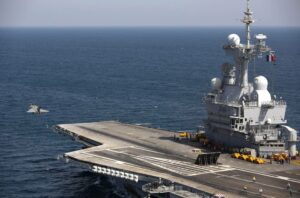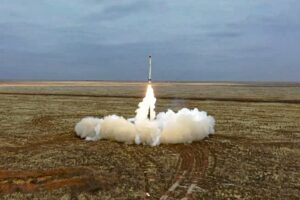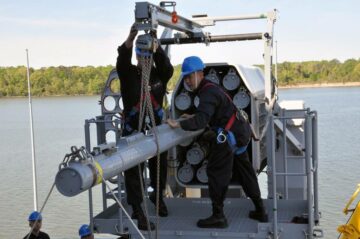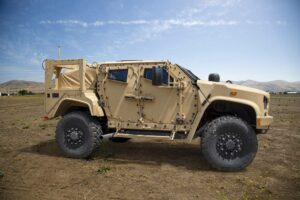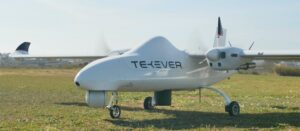WASHINGTON — The Missile Defense Agency’s $10.9 billion fiscal 2024 budget prioritizes regional and homeland missile defense with a major focus on building an air and missile defense architecture in Guam.
Last year, the agency asked for $9.6 billion, but received nearly $1 billion more from Congress. The FY24 request is up nearly 4% from that enacted funding level.
The new proposal includes $8.7 billion in research and development funding, up 6% from last year’s enacted spending. R&D funding accounts for 80% of the FY24 budget proposal.
The MDA is requesting $1.5 billion in procurement funding, 11% less than Congress enacted in FY23, and $564 million in operations and maintenance spending, 4% more than last year.
Defending Guam
The agency is asking for more than $800 million to develop and begin constructing its architecture to defend Guam from air and missile threats. The MDA proposes spending nearly half of the $800 million to continue design and development of the integrated missile defense architecture for the island.
The architecture will be comprised of MDA, U.S. Army and U.S. Navy systems. Part of the effort includes development of the AN/TPY-6 radar for 360-degree coverage, long-range midcourse discrimination, precision tracking and hit assessment.
The request also funds the integration of an Aegis system for Guam with the AN/TPY-6 radar, the dispersed MK41 Vertical Launcher System and a new Army missile launcher.
The MDA also wants to spend $38.5 million to upgrade the Command and Control, Battle Management and Communications (C2BMC) system to support the Guam defense architecture.
RELATED

Regional missile defense spending
Additionally, the MDA is seeking $220.3 million in FY24 for development of the Terminal High Altitude Area Defense system, which provides ballistic missile defense capability in Guam and in South Korea. The agency also requests $47.6 million for testing and $216.8 million to buy 11 interceptors.
The agency is also asking for $89.3 million to support seven THAAD system batteries, including two forward-based batteries stationed in the US Indo-Pacific Command region.
The MDA is requesting $693.7 million for Navy Aegis ships that also provide regional missile defense and more than $800 million to buy 27 Aegis SM-3 Block IB missiles and 12 Aegis SM-3 Block IIA missiles.
The Aegis Ashore system, meant to offer regional defense for Europe, has been operational in Romania since 2016. The MDA is still working to reach operational capability at another Aegis Ashore site in Poland and is seeking $2.4 million to complete the site.
The MDA is also requesting $80.4 million to configure Aegis for land-based defense on Guam and integration with dispersed AN/TPY-6 radar and multiple launchers, according to Pentagon budget documents.
Homeland defense efforts
The MDA continues to develop its Glide-Phase Interceptor, capable of eliminating hypersonic missile threats, and is asking for $209 million in FY24 to fund an ongoing competition between Raytheon Technologies and Northrop Grumman. Both companies are building prototypes after receiving contracts in November 2021.
The agency is also asking for $903.6 million in FY24 to sustain and upgrade its Ground-Based Midcourse Defense System, designed to protect the nation from intercontinental ballistic missile threats from North Korea and Iran.
Additionally, MDA wants another $2.1 billion in FY24 to continue development of its Next-Generation Interceptor. Two teams — Lockheed Martin with Aerojet Rocketdyne and Northrop Grumman with Raytheon Technologies — are competing to build interceptor prototypes.
The NGI is meant to replace the current Ground-Based Interceptors that make up the GMD system. There are 44 GBIs in the ground with the majority in silos at Fort Greely, Alaska, and the rest at Vandenberg Space Force Base, California.
The current interceptors aren’t equipped to counter a missile that could contain multiple kill vehicles or decoys that make the defeat process more complicated, agency officials have said, and the military hopes to have the new interceptor in the ground by 2027 or 2028.
The GMD system will need $41.8 million for testing and $174.8 million for maintenance and sustainment, according to the agency.
Missile defense in space
The agency plans to spend $109.5 million in FY24 for its missile defense space programs, about half what the MDA asked for in FY23.
The funding would go toward the Hypersonic & Ballistic Tracking Space Sensor (HBTSS), a program initiated in 2018 to detect and track hypersonic and ballistic missile threats. L3Harris Technologies and Northrop Grumman each received $277 million contracts in early 2021 to produce prototypes.
The HBTSS is slated to launch in FY23 and remain on orbit in FY24 to validate its performance. Eventually, the Space Force is expected to deploy the capability.
The request also funds the Space-based Kill Assessment project, a network of sensors on commercial satellites capable of delivering hit-to-kill assessments for homeland defense.
Jen Judson is an award-winning journalist covering land warfare for Defense News. She has also worked for Politico and Inside Defense. She holds a Master of Science degree in journalism from Boston University and a Bachelor of Arts degree from Kenyon College.
- SEO Powered Content & PR Distribution. Get Amplified Today.
- Platoblockchain. Web3 Metaverse Intelligence. Knowledge Amplified. Access Here.
- Source: https://www.defensenews.com/pentagon/2023/03/13/missile-defense-agency-prioritizes-guam-in-budget-proposal/
- :is
- $1 billion
- $UP
- 1
- 11
- 2016
- 2018
- 2021
- 2024
- 360-degree
- 7
- 70
- 8
- 9
- a
- About
- According
- Accounts
- After
- agency
- AIR
- and
- Another
- architecture
- ARE
- AREA
- Army
- Arts
- assessment
- assessments
- At
- award-winning
- base
- batteries
- Battle
- BE
- begin
- Billion
- Block
- boston
- Boston University
- budget
- build
- Building
- buy
- by
- california
- capable
- College
- commercial
- Communications
- Companies
- competing
- competition
- complete
- complicated
- Comprised
- Congress
- constructing
- continue
- continues
- contracts
- control
- could
- Counter
- coverage
- covering
- Current
- Defense
- Degree
- delivering
- deploy
- Design
- designed
- develop
- Development
- Discrimination
- dispersed
- documents
- each
- Early
- effort
- equipped
- Ether (ETH)
- Europe
- eventually
- expected
- Fiscal
- Focus
- For
- Force
- Fort
- from
- fund
- funding
- funds
- Go
- Ground
- Half
- Have
- High
- Hit
- holds
- homeland
- hopes
- http
- HTTPS
- image
- images
- in
- includes
- Including
- integrated
- integration
- InterContinental
- Iran
- island
- ITS
- journalism
- journalist
- jpg
- Kill
- korea
- Land
- Last
- Last Year
- launch
- Level
- Lockheed Martin
- maintenance
- major
- Majority
- make
- management
- Martin
- master
- Military
- million
- missiles
- more
- multiple
- nation
- nearly
- Need
- network
- New
- news
- North
- North Korea
- November
- November 2021
- of
- offer
- on
- ongoing
- operational
- Operations
- Orbit
- part
- pentagon
- performance
- plans
- plato
- Plato Data Intelligence
- PlatoData
- Poland
- Precision
- process
- produce
- Program
- Programs
- project
- proposal
- proposes
- protect
- prototypes
- provide
- provides
- R&D
- radar
- reach
- received
- receiving
- region
- regional
- remain
- replace
- request
- requests
- research
- research and development
- REST
- Romania
- s
- Said
- satellites
- Science
- Screen
- seeking
- sensors
- ships
- since
- Since 2016
- site
- South
- South Korea
- Space
- Space Force
- space-based
- spend
- Spending
- Still
- support
- system
- Systems
- teams
- Technologies
- Testing
- that
- The
- threats
- to
- toward
- track
- Tracking
- u.s.
- U.S. Navy
- university
- upgrade
- us
- VALIDATE
- Vehicles
- What
- which
- will
- with
- worked
- working
- would
- year
- zephyrnet

